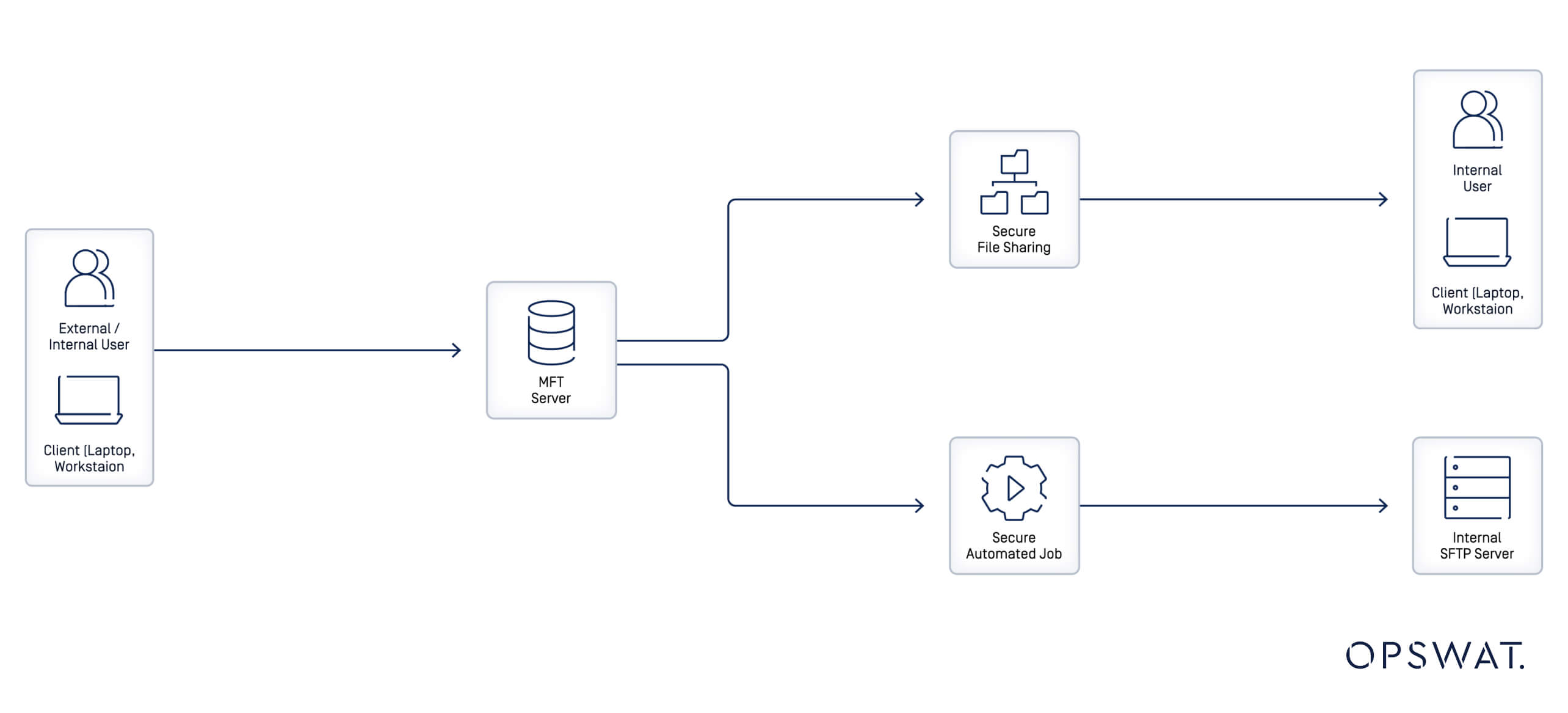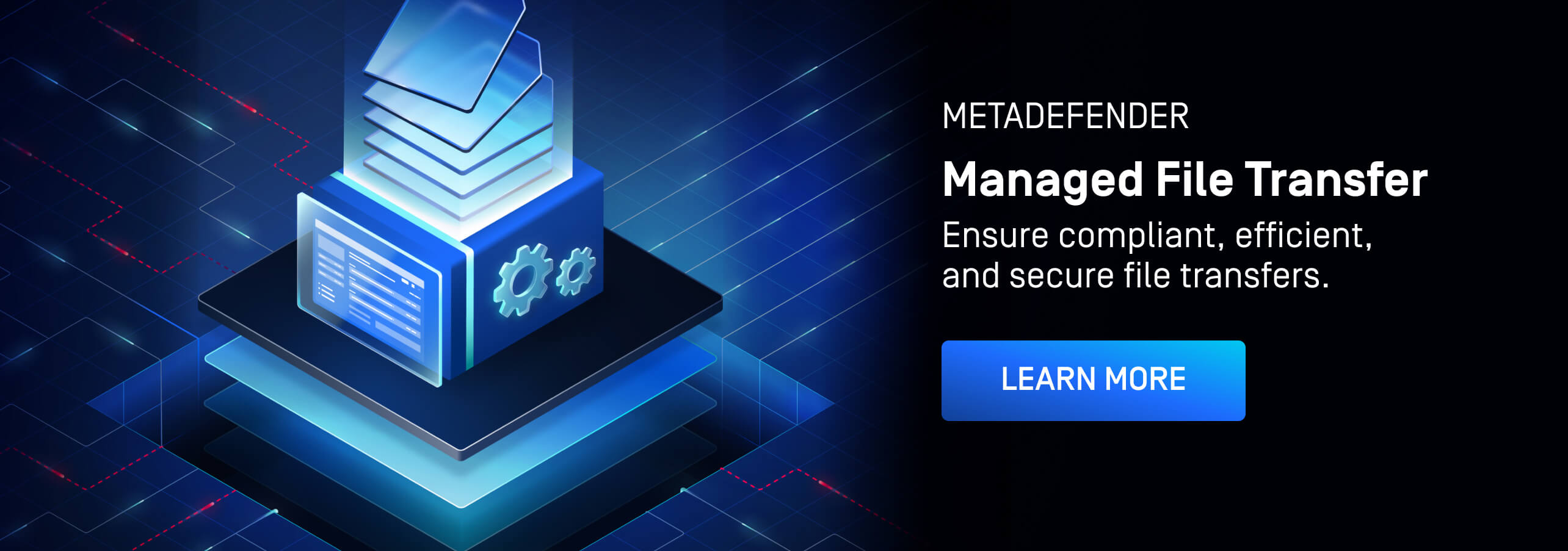Organizations increasingly depend on secure file transfers to manage sensitive data between internal and external parties. And the stakes are higher than ever. According to IBM’s Cost of Data Breach Report, 2024, the global average cost of a data breach increased 10% over the previous year, reaching USD 4.88 million. Limited capabilities in automation, compliance and scalability can expose businesses to operational inefficiencies, data breaches and regulatory penalties.
Many organizations continue to rely on SFTP—an outdated protocol that was never designed to handle the complexities of today’s business environment or the sophistication of modern cyberattacks. As a result, these businesses face rising risks of data breaches, operational delays and reputational damage. The longer they delay adopting secure MFT solutions the more vulnerable they become.
According to Interio’s 2022 Supply Chain Report, 81% of supply chain executives admitted that their organization needs to improve how employees collaborate and share information externally with partners and suppliers.
Managed File Transfer (MFT) solutions offer a transformative alternative, providing enhanced security, automation and scalability. For organizations still using SFTP, it’s time to reassess their strategies and explore how MFT can mitigate risks, ensure compliance and unlock greater operational efficiency.
What is SFTP?
SFTP (Secure File Transfer Protocol) is a protocol for transferring files securely over a network. It ensures encrypted file transfers but often lacks additional automation, compliance and monitoring features that MFT provides.
Enterprises and critical infrastructures that rely on SFTP face significant challenges. Its reliance on manual processes introduces inefficiencies, while the lack of centralized control, file transfer automation and advanced security features exposes organizations to operational vulnerabilities and regulatory risks. In high-security industries, these shortcomings can lead to severe financial and reputational consequences.

What is MFT?
Managed File Transfer is a secure and automated solution that facilitates file transfers between systems, partners, customers and users. It ensures compliance with regulations like HIPAA and GDPR, making it a vital tool for organizations and enterprises with strict data protection requirements.
MFT is widely used in industries such as healthcare, finance and government, where compliance, security and automation are top priorities. In healthcare, MFT ensures secure handling of patient data in accordance with HIPAA regulations. Similarly, financial institutions use MFT to manage large volumes of transactional data while adhering to strict security and compliance standards.

MFT vs. SFTP: Key Differences
By addressing the core needs of IT-OT convergence, MetaDefender Managed File Transfer (MFT) enables organizations to drive their digital transformation forward with a focus on secure data flow, seamless connectivity and collaborative tools. Here is a closer look at the unique capabilities MetaDefender Managed File Transfer (MFT) delivers:
Security
While SFTP provides basic encryption for file transfers, its security capabilities fall short in large-scale operations facing increasingly sophisticated threats. MFT offers end-to-end encryption, antivirus scanning, data loss prevention (DLP) and centralized control, ensuring comprehensive protection. Without these features, SFTP leaves organizations vulnerable to breaches and compliance failures.
Automation
MFT automates workflows, reducing manual effort and human intervention, while SFTP relies on manual configuration for each file transfer. MFT’s centralized control ensures smooth, error-free transfers, streamlining processes and freeing IT teams to focus on more strategic tasks.
Compliance
MFT includes built-in compliance tools, such as audit logs and regulatory reporting, ensuring adherence to stringent standards like HIPAA, GDPR, and SOX. In contrast, SFTP requires external configurations to meet compliance needs, increasing complexity and risk.
Scalability
MFT is designed to scale according to organizational growth, providing tools for high-volume data transfers and integration across cloud platforms. SFTP, in contrast, is only suited for smaller operations that do not demand high scalability.
User-Friendliness
MFT platforms are designed with intuitive user interfaces, allowing both technical and non-technical users to manage file transfers easily. SFTP, however, requires more technical expertise for setup and use.
Monitoring & Reporting
MFT offers comprehensive tracking and reporting features, providing real-time visibility into file transfers. SFTP lacks these centralized tracking capabilities, which can make monitoring more challenging.
Integration Capabilities
Some MFT products can integrate seamlessly with cloud platforms like AWS, Microsoft Azure, and Google Cloud, enabling secure file transfers across various environments. SFTP, in contrast, often operates in silos and struggles to connect with today’s interconnected systems.
Reliability
MFT is optimized for reliability, with features like file integrity validation and automatic retries in the event of transfer failures. SFTP does not offer these capabilities, making it prone to disruptions that can jeopardize operations in high-security environments.
MFT vs. SFTP: Pros and Cons
| MFT | SFTP | |
| Pros |
|
|
| Cons |
|
|
When to Use MFT vs. SFTP: Industry Use Cases
As organizations across various industries manage increasingly complex data transfer needs, choosing between MFT and SFTP depends on factors like automation, compliance and scalability. MFT is ideal for organizations that need to handle large volumes of sensitive data, automate workflows and meet stringent compliance requirements.
SMBs (Small to Medium-Sized Businesses)
SFTP may be sufficient for smaller businesses with simple file transfer needs, but it comes with inherent risks. Its lack of automation and compliance tools means manual processes are prone to human error, which can lead to delays or data mishandling.
Additionally, as SMBs grow or start handling more sensitive information, the limitations of SFTP become a liability. Without advanced security features or centralized oversight, businesses relying on SFTP are more vulnerable to breaches, operational inefficiencies and penalties for non-compliance.
Example: In retail, SFTP is often used to transfer product catalogs or transactional data. If a small retail chain sends inventory updates to suppliers via SFTP without automation or monitoring then a failed transfer could disrupt supply chains and result in stock shortages.
Additionally, transferring sensitive customer data without advanced encryption or compliance tools increases the risk of breaches and penalties. As retail businesses scale, these vulnerabilities make SFTP a liability.
Healthcare
Many healthcare systems use MFT solutions to securely exchange large volumes of patient data across their networks. MFT ensures compliance with regulations like HIPAA, which govern the protection of sensitive health information, and provides features like encryption, audit trails and automation to enhance security and efficiency in managing patient records and other healthcare data.
Example: A large hospital network using MFT can securely send test results from a lab to a physician, ensuring patient data integrity and confidentiality. This centralized solution also automates the exchange of patient data with insurance companies for faster claims processing. Discover how Unique Wire safely restored a major healthcare provider’s compromised network with the help of OPSWAT’s MetaDefender Managed File Transfer (MFT) here.
Finance
Banks use MFT solutions to securely handle large volumes of financial transactions, such as managing encrypted data transfers for interbank transactions while complying with SWIFT Standards, SOX, and GLBA requirements. MFT also automates the secure exchange of sensitive customer information to prevent data leaks and fraud.
Example: A multinational bank relies on MFT to automate the transfer of encrypted transaction records between its global branches, helping it comply with SWIFT standards while ensuring data integrity. The solution also reduces the risk of data leaks when handling sensitive customer information. Read our article to learn why Managed File Transfer is a cornerstone of preventive cybersecurity technology in the financial sector here.
Energy and Utilities
MFT ensures secure file transfers for critical infrastructure data between IT and OT systems, helping utilities comply with standards like NIS2 and NIST. Its advanced security features, such as real-time monitoring and malware detection, provide an essential layer of defense for SCADA systems and supply chain operations.
Example: A utility company leverages MFT to securely exchange critical infrastructure data between its IT and OT networks, mitigating risks associated with cyber threats to SCADA systems. This automated system ensures compliance with NIS2 and NIST standards while protecting sensitive operational data. Discover how nuclear facilities around the world can use MFT to ensure file security here.
Manufacturing
Manufacturers leverage MFT to securely transfer blueprints and production data while safeguarding their OT environments against file-based cyber threats. With built-in compliance tools for GDPR and ISO 27001, MFT ensures secure collaboration across the supply chain. Its ability to handle large-scale data transfers reliably makes it an essential tool for the modern manufacturing supply chain.
Example: A global manufacturer employs MFT to securely share blueprints, CAD files, and production schedules with its suppliers and partners. This not only safeguards proprietary information but also ensures compliance with GDPR and ISO 27001, reducing the risk of data breaches in the supply chain. Find out how OPSWAT's MetaDefender Managed File Transfer (MFT) has significantly enhanced the security and efficiency of file transfers for this global automotive company. Read here.
Government
Agencies require robust file transfer solutions to protect classified documents and citizen data. MFT offers advanced security features, including centralized management and detailed audit logs, to ensure compliance with ISO/IEC 27001 and other data protection standards. Its ability to handle sensitive transfers securely makes it essential for national and regional governments.
Example: One ministry needs to share sensitive budgetary reports with another ministry. Using SFTP, such transfers could lack centralized monitoring and audit trails, making it difficult to ensure that data reaches the correct recipient securely and compliantly.
Furthermore, if a cyberattack exploits vulnerabilities in the SFTP setup, the ministry risks exposing sensitive national information, leading to significant security and reputational consequences. By adopting MFT, centralized oversight, real-time monitoring and detailed audit logs, the ministry can ensure secure and compliant data transfers.
Media
Media companies deal with large files and sensitive intellectual property that require secure and efficient transfers. MFT provides end-to-end encryption and centralized management enabling secure transfers of large video files and protecting intellectual property against piracy. It ensures compliance with media-specific standards like DRM and ATSC, along with GDPR and CCPA.
Example: A broadcasting company uses MFT to transfer large video files between its headquarters and production studios worldwide. This ensures the protection of intellectual property and prevents unauthorized access, helping the company comply with DRM and CCPA regulations.
MFT vs. SFTP: Total Cost of Ownership
While MFT comes with higher upfront costs due to licensing and setup, its automation, security and compliance features reduce operational costs over time. Maintenance and scalability are also factors that favor MFT, as they help avoid the risks and penalties associated with data breaches and compliance failures.
SFTP’s lower initial cost may seem attractive, but its lack of advanced features can increase long-term costs as businesses grow and their data transfer requirements become more complex. The lower initial cost of SFTP can increase long-term costs due to:
- Manual processes and labor costs
- Compliance and Security Gaps
- Limited Scalability and Integration
- Higher Risk of Data Breaches
- Increased Maintenance and Management Costs
5 Reasons to Migrate from SFTP to MFT
- SFTP provides basic secure file transfers, but it lacks the advanced features required to handle complex workflows, ensure compliance and protect against sophisticated cyberattacks. Reliance on SFTP exposes organizations to significant vulnerabilities and inefficiencies.
- MFT, on the other hand, offers enhanced control, allowing administrators to define user-specific permissions, ensuring only authorized access to sensitive data. Centralized, real-time file transfer monitoring and workflow management ensure seamless operations, enhance visibility and enable quick resolution of issues, all while maintaining robust security and compliance standards.
- Unlike SFTP, MFT encrypts files both in transit and at rest, safeguarding data throughout its lifecycle while generating detailed audit logs to support compliance and simplify regulatory reporting.
- Beyond compliance and control, MFT integrates advanced threat detection to scan files for malware, including zero-day vulnerabilities, before they are shared. This proactive protection mitigates risks and ensures secure collaboration.
- With centralized management and automation, MFT eliminates the inefficiencies of manual processes, enabling organizations to scale securely and efficiently. For businesses facing growing data volumes and evolving regulatory requirements, MFT is more than an upgrade—it is a strategic move.
Failing to transition to MFT can expose businesses to critical vulnerabilities. Without automation, real-time monitoring, and advanced compliance tools, organizations risk data breaches, inefficiencies, and regulatory penalties. The risks of relying on SFTP are far too great, and the costs of inaction continue to climb.

Selecting the Best File Transfer Solution
While both MFT and SFTP provide secure file transfers, MFT is the superior choice for large organizations and enterprises needing automation, compliance, scalability, and reliability.
SFTP remains a viable option for smaller organizations with fewer security and automation requirements. As businesses grow, the migration from SFTP to MFT becomes inevitable to maintain security, compliance, and operational efficiency.
Discover how OPSWAT's industry-leading MFT solution, MetaDefender Managed File Transfer (MFT), can enhance the security and compliance of your file transfer workflows, ensuring data protection and regulatory adherence.



